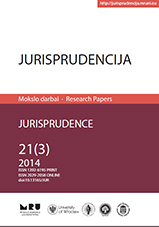INTERACTION BETWEEN RECOGNITION AND SUCCESSION OF STATES
INTERACTION BETWEEN RECOGNITION AND SUCCESSION OF STATES
Author(s): Birutė Kunigėlytė-ŽiūkienėSubject(s): Law, Constitution, Jurisprudence
Published by: Mykolas Romeris University
Keywords: recognition of state; succession of states; successor state; predecessor state
Summary/Abstract: The first question arising once a new international law subject appears (or declares to be appeared) in international community is the question of recognition, and the question of succession of states is in some instances dependent on the former and comes afterwards. It is obvious that these two institutes of international law are closely interrelated, and in some cases the undertaking to solve the questions of succession has been considered as one of the recognition prerequisites. Recognition plays a major role when solving questions of succession, especially depending on the type of creation of a new state. Once the creation of a new state is peaceful and agreed, in most cases the recognition follows shortly, and the questions of succession are being agreed upon afterwards without problems. If the creation of the state is not agreed with a predecessor state (usually in cases of secession), it might take time to solve the questions of recognition as well as those of succession, therefore, the recognition of a predecessor state plays a major role. In cases of continuity of the predecessor state (which is not a form of succession, but rather the further existence of the predecessor state), recognition – initially by other subjects of a certain legal relation – successor states – has a constitutive meaning. It must be noted that if an entity declares itself to be independent or incorporated into another country on the basis of a breach of international law, other subjects of international law usually use the non-recognition policy. In this case, no state succession should take place.
Journal: Jurisprudencija
- Issue Year: 21/2014
- Issue No: 3
- Page Range: 731-757
- Page Count: 27
- Language: English

